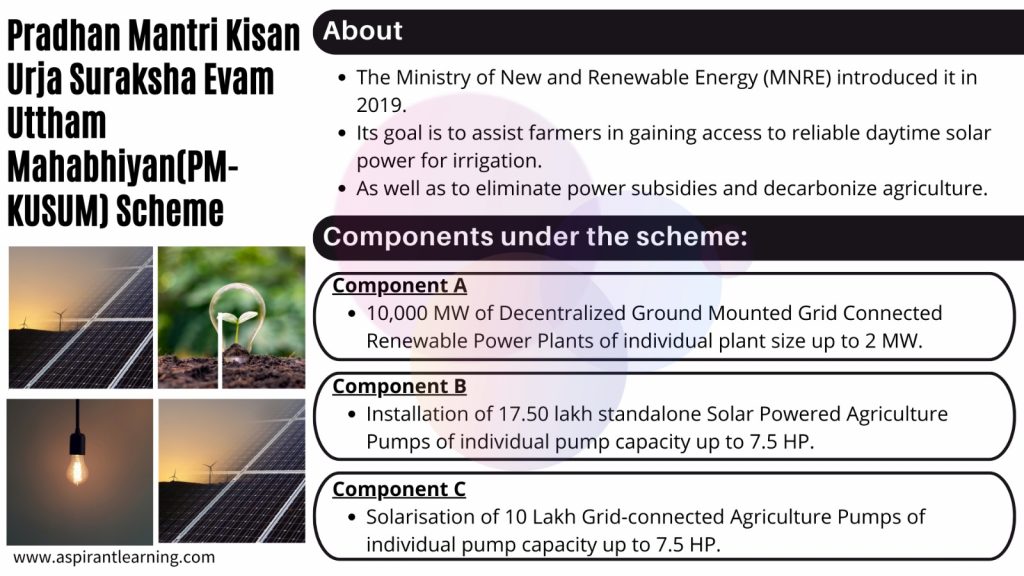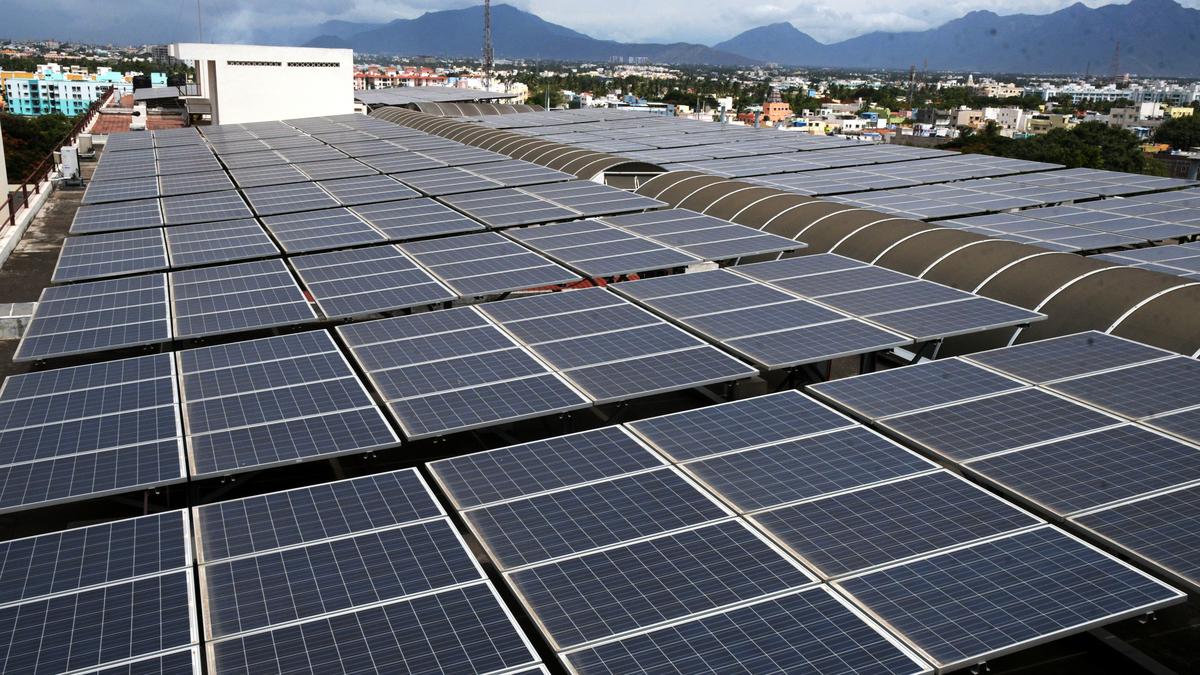News Highlight
The pace of implementation of PM-KUSUM was significantly affected due to the COVID-19 pandemic.
Key Takeaway
- The deadline for the Ministry of New and Renewable Energy’s flagship project to instal 30,000 MW of solar power capacity in rural India by 2022 has been put back to March 2026.
PM-KUSUM (Pradhan Mantri Kisan Urja Suraksha Evam Uttham Mahabhiyan) Scheme
- About
- The Ministry of New and Renewable Energy (MNRE) introduced the PM KUSUM Scheme in 2019.
- It aimed to deploy solar pumps, grid-connected solar, and other renewable power plants around the country.
- The Government of India’s PM-KUSUM scheme is one of the world’s most significant initiatives to deliver clean energy to more than 3.5 million farmers.
- This would be accomplished by solarising their irrigation pumps.
- The scheme intends to build 30.8 GW of solar capacity by December 31, 2022, with a total investment of INR 340.35 billion.
- Objectives
- Farm sector de-dieselisation.
- Providing farms with water and energy security.
- Increasing farmers’ income.
- Reducing pollution in the environment.
Features of The PM-KUSUM Scheme
- The central government initially intended to distribute 1.75 million off-grid agricultural solar pumps.
- Farmers’ unused land install around 10000 MW of solar pumps.
- Additional electricity generated by these pumps can be sold to DISCOMs, or state electricity distribution firms.
- Subsidies will be available for DISCOMs to purchase this electricity.
- Farmers would be able to receive a 60% subsidy on solar pumps.
- This sum will be remitted to their bank accounts via Direct Benefit Transfer (DBT).
- The national and state governments will split the subsidy sum.
- Farmers will receive 30% of the remaining funds as a loan.
- As a result, farmers will only have to bear 10% of the cost.
Significance of the Scheme
- Source of Income
- The project will provide rural landowners with a steady and ongoing source of income for the next 25 years by utilising their dry/uncultivable land.
- It would also assist in enhancing green energy generation and creating jobs in rural areas.
- Energy Availability and Security
- Rural load centres and agricultural pump-set loads primarily require power during the day.
- The system would ensure enough local solar; other renewable energy-based power to feed them.
- Less transmission losses
- As these power plants will be decentralised, they will be closer to agricultural loads or electrical substations.
- Transmission losses for STUs and Discoms will be decreased as a result.
- Furthermore, the plan will assist Discoms in meeting the RPO target.
- Reduced expenditure
- Solar pumps would reduce the cost of diesel used to power diesel pumps while also providing farmers with a reliable source of irrigation.
- Environment-Friendly
- The system will aid in preventing dangerous emissions caused by the operation of diesel pumps.
- Contain Climate Catastrophe
- Farmers will be incentivised to save energy if they can sell extra power, resulting in groundwater’s reasonable and efficient use.
- Additionally, expanding irrigation coverage by enabling decentralised solar-based irrigation and transitioning away from polluting diesel.
- When completely implemented, PM-KUSUM will reduce carbon emissions by up to 32 million tonnes of CO2 annually.
Challenges Associated with the Scheme
- Regulatory Barriers and Stability
- There may be regulatory obstacles that hinder the scheme from being implemented smoothly.
- Such as restrictions on solar power project grid connection.
- Integrating dispersed solar power plants into the grid may present technical and stability concerns that must be solved.
- Depleting Water Tables
- Because of power subsidies, the recurring cost of electricity is so low that farmers continue to pump water, causing the water table to fall.
- In a solar project, upgrading to larger capacity pumps becomes more complicated if the water table falls because new solar panels, which are expensive, can be added.
- Lack of trust
- The grid-connected model necessitates measuring and billing pumps for accounting purposes.
- But it needs more confidence between farmers and DISCOMs.
- Awareness
- Farmers’ inability to pay their upfront contribution is one of the most significant barriers to adoption.
- COVID
- Pandemic-induced disruptions, limited purchasing from states, and implementation issues have hampered the scheme’s rollout.
- Financial and Logistics Issue
- The cost of establishing solar power installations can be prohibitively expensive.
- Some farmers may need access to the necessary financing.
- There needs to be domestic availability of equipment.
- While local suppliers see no difficulty in supplying pumps, the availability of solar pumps remains an issue.

Way Forward
- Most Indian DISCOMs have an excess of contractual generation capacity and are hesitant to acquire additional electricity in the immediate future.
- Extending the deadlines for PM KUSUM beyond 2022 would allow DISCOMs to integrate the programme into their power purchase planning.
- Encourage creative approaches to funding farmer contributions.
- Adopting technologies such as smart metres and intelligent transformers, as well as communicating with farmers, can help to develop trust.
Pic Courtesy: The Hindu
Content Source: The Hindu



